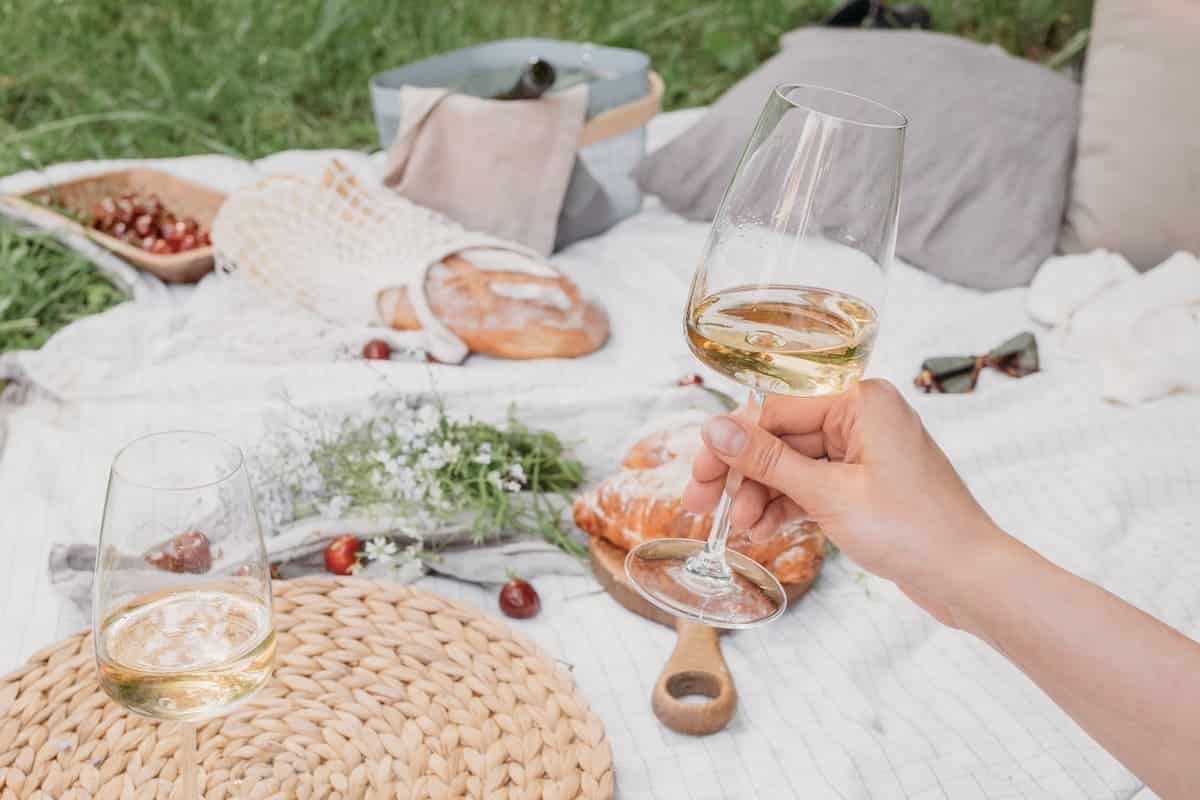Here in the Napa Valley, things start really heating up in May. The vineyards are fully decked out in their foliage, and the visitors are here to take in the sunshine, scenery, and, of course, the wine! While Napa is virtually synonymous with Cabernet Sauvignon, warmer weather gets many of us thinking about white wine.
What Makes White Wine So Appealing on a Warm Day?
There are several reasons why white wine is perfect for sipping when the temperatures climb: the lack of tannins, fruity and floral aromas, and crisp acidity all speak of lightness and refreshment.
These are just a few reasons to celebrate White Wine Month in May. Later, we’ll explore the specific wine holidays this month brings—but first, an overview of what white wine is and how it’s made.
What Is White Wine and How Is It Made?
White Grapes and the Winemaking Process
White wine is made from white grapes—those with pale green, golden, or even dusty pink skins. (Some of these grapes are actually colorless mutations of red grapes; Pinot Blanc comes to mind.) Their skins lack the anthocyanins that give red wines their color. However, they do contain tannins, so the first step after sorting the fruit is to press the grapes. This releases the juice while leaving the tannins and pigments in the skins and seeds behind.
Skin-Contact Wines
Of course, there are exceptions. When a white grape wine undergoes skin contact during fermentation, it becomes what we call a skin-contact white. If the skins remain throughout primary fermentation, the result is an “orange” or “amber” wine. While some Napa Valley whites undergo brief skin contact, it’s usually not enough to classify them as orange wines. For true skin-contact styles, look to countries like Georgia (in the Caucasus) or the Balkans, where this approach has been perfected over centuries.
Settling the Juice
At Hill Family Estate, we use a quick pressing method with no skin contact. The juice isn’t perfectly clear at this point, so we cold-settle it by chilling it to around 32°F for 24–48 hours. This allows solids to settle at the bottom and helps precipitate excess tartaric acid, which reduces the risk of forming “wine diamonds” later in the bottle.
Once the solids have settled, we rack the juice—meaning we pump it off the lees (the settled solids) to yield clean, clear juice for fermentation. We generally inoculate the entire batch and either ferment in the tank or transfer it to barrels.
Barrel Fermentation and Micro-Oxygenation
If we use wooden barrels, a tiny amount of oxygen enters through the pores in the wood. This micro-oxygenation process softens acidity and gives the wine a silkier texture. Allowing the wine to age in barrel post-fermentation enhances this effect.
Malolactic Fermentation
For our Reserve Chardonnay, we also initiate malolactic fermentation—a secondary process that converts sharp malic acid (think Granny Smith apples) into softer lactic acid (found in milk). This transformation not only mellows acidity but also produces diacetyl, the compound responsible for the wine’s signature creaminess.
Fermentation Choices: Tank or Barrel?
At Hill Family Estate, we tailor fermentation to the style of wine we’re crafting. Our bright, crisp Carneros Albariño is fermented in stainless steel tanks. Our Reserve Chardonnay, on the other hand, is fermented in oak barrels for richness and texture.
The choice of barrel matters too. A wine barrel releases about 80% of its aroma compounds in its first year. For whites, we reserve new barrels for the Reserve Chardonnay. Other whites are fermented or aged in one- or two-year-old barrels for subtle oak influence, or older barrels (three years or more) that offer micro-oxygenation without adding oak flavors.
Bâtonnage and Aging
During barrel aging, we may practice bâtonnage—stirring the wine every two weeks for about three months to incorporate the lees. This enhances mouthfeel and adds a creamy texture. When aging is complete, we rack the wine again into tanks and hold it in an oxygen-free environment to allow the various lots to integrate.
Fining, Filtration, and Bottling
Before bottling, the wine may be fined and filtered to ensure brilliant clarity. After bottling, the wine rests briefly to recover from bottle shock—a temporary condition caused by the agitation of bottling.
Pairing Food with White Wine
Wine and food pairings follow many guidelines—some rooted in chemistry, others in tradition, and a few that are open to interpretation. One commonly accepted rule is to avoid pairing tannic reds with fish, spicy foods, or sweets. Tannins can amplify fishiness, intensify spice, and clash with desserts.
That makes white wines ideal for dishes like seafood, curry, or fresh fruit. Beyond that, there are two main approaches to pairing: congruent and contrasting.
Congruent Pairings
In the words of Madeline Puckette in Wine Folly, “A congruent pairing creates balance by amplifying shared flavor compounds.” For example, pair the buttery notes of our Reserve Chardonnay with local Dungeness crab served with melted butter.
Contrasting Pairings
Puckette also defines contrasting pairings as those that “create balance by contrasting tastes and flavors.” Think of pairing the rich texture of raw oysters with the bright citrus of our Carneros Albariño.
For a deeper dive, Wine Folly: Magnum Edition is an excellent resource. And of course, a sommelier can offer personalized guidance when dining out.
May’s White Wine Celebrations
White Wine Month isn’t the only reason to raise a glass in May—several notable wine days occur this month:
First Friday in May: International Sauvignon Blanc Day
Sauvignon Blanc is a Napa Valley staple. Our Napa Valley Sauvignon Blanc is fermented in stainless steel and aged in mostly stainless barrels for a vibrant profile. For a softer expression, our Tiara Sauvignon Blanc is fermented and aged in oak barrels, yielding aromas of nectarine and marzipan. Perfect with food—or as a celebratory solo sip!
Thursday Before Memorial Day: Chardonnay Day
Celebrate Chardonnay Day with a glass of Reserve Chardonnay. For an unforgettable dinner, pair it with saffron risotto and seared sea scallops. Prefer a lighter style? Try Carly’s Cuvée Chardonnay, which is bright and unoaked, with no malolactic influence.
May 24: Anniversary of the Judgement of Paris
This historic tasting put Napa Valley on the world wine map. Celebrate by opening a Napa wine and watching Bottle Shock—the dramatized retelling of this legendary event.
May 25: National Wine Day
No rules here—just open your favorite bottle. As Madeline Puckette puts it:
“No need to get too specific on this day. Just find a bottle of your favorite winery, grape, or style, and enjoy. The perfect wine holiday!” – Wine Folly
Whatever your choice of wine, please let us at Hill Family Estate wish you a very happy White Wine Month!

